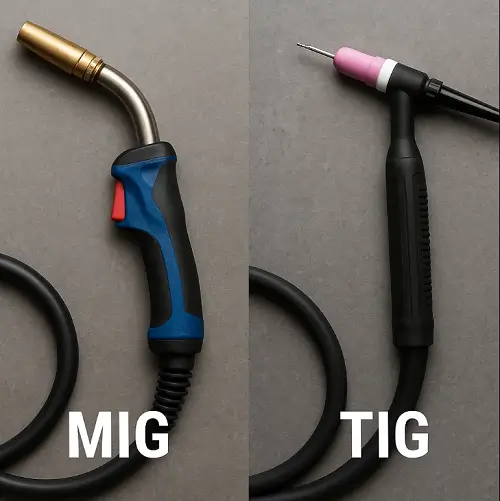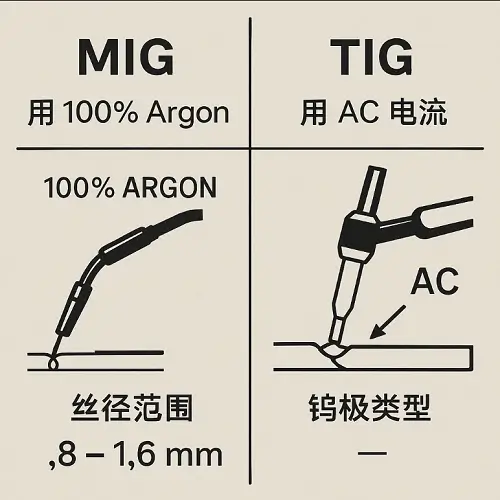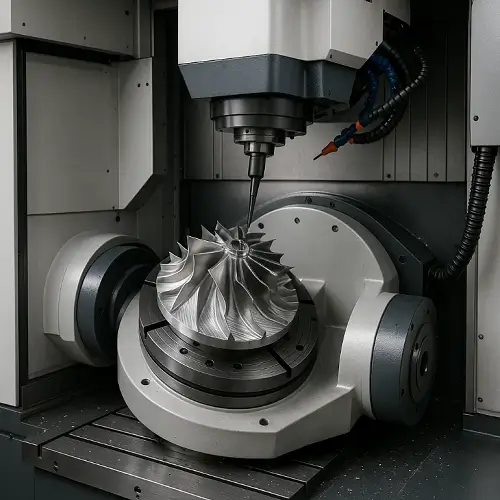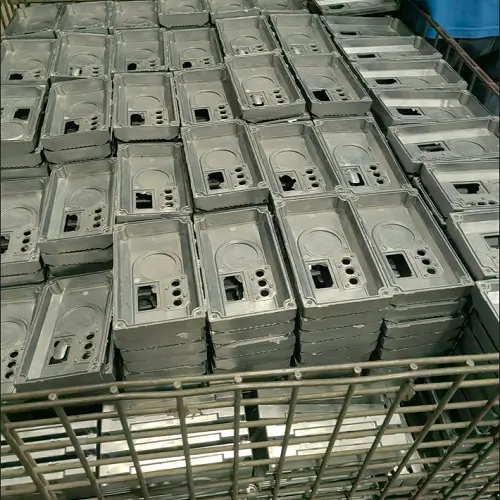When aluminum is the base material, the choice between MIG vs TIG welding determines how quickly the job gets done, how much distortion the part suffers, and how clean the weld bead appears. Aluminum’s high thermal conductivity, oxide layer, and expansion rate make welding process selection more critical than with most metals.
In this article, TIG vs MIG welding for aluminum is examined from a technical perspective—covering deposition rates, parameter settings, joint preparation, and real-world applications. For detailed cleaning, preparation, and process alternatives, refer to How to Weld Aluminum: A Detailed Guide.
MIG Welding for Aluminum
Definition and Setup
MIG welding aluminum, or Gas Metal Arc Welding (GMAW), feeds a consumable aluminum wire continuously through a spool gun or push–pull system, shielded with 100% argon or an argon–helium mix. Wire diameters typically range from 0.9 to 1.2 mm for most structural work.
Typical Parameters:
-
Voltage: 18–26 V for material ≥ 3 mm
-
Current: 120–250 A, depending on thickness and joint design
-
Wire: ER4043 for better fluidity, ER5356 for higher strength
-
Gas flow: 14–18 L/min (pure argon), up to 20 L/min for argon–helium
Advantages:
-
Deposition rates up to 2 kg/h on thick plate
-
Lower skill threshold compared to TIG
-
Efficient for welding 6061 aluminum and welding 5052 aluminum in large sections
-
Well suited to aluminum boat hulls, trailer frames, and other large assemblies
Limitations:
-
Higher risk of porosity without thorough surface prep
-
Bead profile less aesthetic than TIG
-
Less control over heat input—can cause warping on sheet under 3 mm
TIG Welding for Aluminum
Definition and Setup
TIG welding aluminum, or Gas Tungsten Arc Welding (GTAW), uses a non-consumable tungsten electrode with AC current to break through the oxide layer, adding filler rods separately when needed. The torch is often water-cooled for high-amperage work.
Typical Parameters:
-
Amperage: 60–200 A AC with balance control
-
Electrode: Pure tungsten or zirconiated tungsten, 2.4 mm for most jobs
-
Filler rods: ER4043 for crack-sensitive alloys, ER5356 for higher tensile requirements
-
Gas flow: 10–14 L/min with pure argon
Advantages:
-
Clean, precise weld bead with minimal spatter
-
Excellent control for welding thin aluminum sheet down to 1.5 mm
-
Preferred for visible or high-spec joints, such as aluminum bike frames and aerospace components
Limitations:
-
Slower deposition rates—0.5–0.7 kg/h typical
-
Higher operator skill requirement
-
Less economical for thick sections in production work
MIG vs TIG Welding: Key Differences for Aluminum
| Feature | MIG Aluminum Welding | TIG Aluminum Welding |
|---|---|---|
| Welding speed | High (1.5–2.0 kg/h) | Low (0.5–0.7 kg/h) |
| Weld appearance | Functional, may need finishing | Excellent, smooth finish |
| Skill requirement | Moderate | High |
| Thick section suitability | Excellent | Limited |
| Thin section suitability | Fair | Excellent |
| Typical gas | Argon or argon–helium | Pure argon |
| Best for production runs | Yes | Limited |
Parameter Considerations
-
MIG welding aluminum settings must match wire diameter, gas type, and travel speed to avoid undercut or porosity.
-
TIG welding aluminum thickness choice drives amperage—3 mm plate may require 150 A, while thin sheet can be joined at 60–80 A.
-
Gas choice matters: aluminum welding gas type MIG can include helium blends for deeper penetration; aluminum welding gas type TIG typically stays pure argon for arc stability.
Common Defects and How to Prevent Them
-
Aluminum welding defects MIG: Porosity from contamination—brush with stainless steel, degrease with acetone, and ensure gas coverage.
-
TIG welding aluminum cracking: Preheat thick sections to 150–200 °C, choose filler alloy to match base metal expansion rates.
-
Prevent porosity in aluminum welding: Keep filler rods dry, store wire in sealed containers, and avoid drafts in the weld zone.
-
Avoid warping in aluminum welding: Use proper clamping, sequence welds to balance heat, and limit dwell time.
Choosing Between MIG and TIG
In the mig welder vs tig decision for aluminum:
-
Use MIG for 4 mm+ plate, large structural jobs, and high-output environments.
-
Use TIG for thin sections, precision assemblies, or when weld aesthetics are a priority.
-
Many fabrication shops run both—MIG for speed and heavy work, TIG for detail and finishing.
For additional preparation and quality-control measures, see How to Weld Aluminum: A Detailed Guide.
For project-specific process selection, visit our Aluminum Welding Services.
FAQ: MIG vs TIG Aluminum Welding
Q1: MIG welder vs TIG welder — which is better for aluminum boats?
MIG is faster for large hull panels; set voltage around 24 V with 1.2 mm ER5356 wire. TIG is better for finishing visible joints and small fittings.
Q2: Which is stronger — TIG vs MIG welding aluminum?
With correct parameters, both meet design strength. TIG often yields lower defect rates on thin material.
Q3: Can you MIG weld thin aluminum sheet?
Yes. For 2 mm sheet, use 0.9 mm ER4043 wire, 18 V, and push technique to control heat.
Q4: Can you TIG weld thick aluminum plate?
Possible with preheat and high amperage, but MIG is more efficient for production.
Q5: What tungsten electrode for TIG welding aluminum?
Pure tungsten for most work; zirconiated for higher current AC welding.
Q6: What filler rod for TIG welding aluminum?
ER4043 for improved flow and crack resistance, ER5356 for higher strength.




